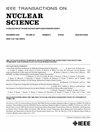适合航天任务应用的辐射屏蔽复合材料的优化
IF 1.9
3区 工程技术
Q3 ENGINEERING, ELECTRICAL & ELECTRONIC
引用次数: 0
摘要
与多层材料相比,新型复合材料更适合于空间应用中的辐射屏蔽,因为层与层之间不同的热膨胀系数使多层材料在空间冷热交替的条件下更容易受到损伤。这些先进的复合材料设计了各种材料系统,每种材料系统都经过优化,可以提供不同的屏蔽电子和质子辐射的性能。在不同的轨道任务中,辐射粒子的能谱变化很大,影响了这些材料的屏蔽性能。本研究采用前向蒙特卡罗(FMC)模拟方法,与地面实验进行了初步比较。然后模拟不同复合材料解决方案的屏蔽效果,以便在各种轨道辐射环境和剂量下进行比较,并评估不同材料系统在特定轨道上的性能优势。研究表明,辐射屏蔽材料的设计是一个受多种因素影响的复杂工程过程。这就要求材料体系的设计要考虑任务轨道辐射环境特性、面质量、总电离剂量(TID)硬度保证阈值等因素,根据不同元素的屏蔽性能进行设计。中地球轨道(MEO)和地球静止轨道(GEO)任务的复合材料优先考虑提高电子屏蔽性能。同时,低地球轨道(LEO)、低极地球轨道(LPEO)和赤道近地轨道(EMEO)不同的辐射环境特性,要求针对特定条件的材料优化设计方案。结果表明,仿真驱动的定量方法可以实现精确设计,在保证可靠性的同时最大限度地降低成本。本文章由计算机程序翻译,如有差异,请以英文原文为准。
Optimization of Radiation Shielding Composite Materials Tailored for Space Mission Applications
New composite materials are more suitable for radiation shielding in space applications compared to multilayer materials as the differing thermal expansion coefficients between layers make multilayer materials more susceptible to damage in the alternating hot and cold conditions of space. These advanced composites are designed with various material systems each optimized to provide distinct shielding properties against electron and proton radiation. The energy spectra of radiation particles vary significantly across different orbital missions affecting the shielding performance of these materials. This study employs a forward Monte-Carlo (FMC) simulation approach initially compared by the ground-based experiments. The shielding effectiveness of different composite material solutions is then simulated allowing for comparison across various orbital radiation environments and doses and evaluating the performance advantages of distinct material systems in specific orbits. This research has shown that the design of radiation shielding materials is a complex engineering process influenced by multiple factors. It requires the material system to be designed based on the shielding properties of different elements considering factors such as the radiation environment characteristics of the mission orbit, areal mass, and the threshold for total ionizing dose (TID) hardness assurance. Composites for missions in the medium Earth orbit (MEO) and geostationary orbit (GEO) prioritize enhancing electron shielding performance. Meanwhile, the distinct radiation environment characteristics of the low Earth orbit (LEO), low polar Earth orbit (LPEO), and equatorial MEO (EMEO) demand material solutions of optimal designs tailored to specific conditions. The results show that the simulation-driven quantitative approach enables precise designs that ensure reliability while minimizing costs.
求助全文
通过发布文献求助,成功后即可免费获取论文全文。
去求助
来源期刊

IEEE Transactions on Nuclear Science
工程技术-工程:电子与电气
CiteScore
3.70
自引率
27.80%
发文量
314
审稿时长
6.2 months
期刊介绍:
The IEEE Transactions on Nuclear Science is a publication of the IEEE Nuclear and Plasma Sciences Society. It is viewed as the primary source of technical information in many of the areas it covers. As judged by JCR impact factor, TNS consistently ranks in the top five journals in the category of Nuclear Science & Technology. It has one of the higher immediacy indices, indicating that the information it publishes is viewed as timely, and has a relatively long citation half-life, indicating that the published information also is viewed as valuable for a number of years.
The IEEE Transactions on Nuclear Science is published bimonthly. Its scope includes all aspects of the theory and application of nuclear science and engineering. It focuses on instrumentation for the detection and measurement of ionizing radiation; particle accelerators and their controls; nuclear medicine and its application; effects of radiation on materials, components, and systems; reactor instrumentation and controls; and measurement of radiation in space.
 求助内容:
求助内容: 应助结果提醒方式:
应助结果提醒方式:


